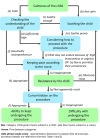"Keeping pace according to the child" during procedures in the paediatric intensive care unit: A grounded theory study
- PMID: 29550158
- PMCID: PMC6004326
- DOI: 10.1016/j.iccn.2018.02.006
"Keeping pace according to the child" during procedures in the paediatric intensive care unit: A grounded theory study
Abstract
Objective: The goal was to explore how nurses interact with children in the paediatric intensive care unit during potentially painful procedures.
Research methodology/design: This was a qualitative research study that used grounded theory approach. Data were collected through participant observation and interviews. Nurse-child interactions were observed and recorded during potentially painful procedures performed by nurses. Following observation of a procedure, nurses were interviewed about their intentions, feelings and emotions during the procedure.
Setting: The study took place in a seven-bed paediatric intensive care unit in an academic teaching hospital in Japan.
Findings: Children's acceptance of a procedure was induced by nurses' pacing, particularly in a pattern of "keeping pace according to the child." Such pacing involved soothing the child, explaining what was being done to the child at each step and acknowledging the child's emotions. All of these child-centred procedures provoked cooperation from the children even during painful procedures.
Conclusions: Our study suggests that a collaborative practice approach, in which nurses use a series of calming tactics, might improve children's perceptions of painful procedures.
Keywords: Child; Grounded theory; Interactions; Paediatric intensive care; Painful procedures; Qualitative research.
Copyright © 2018 Elsevier Ltd. All rights reserved.
Conflict of interest statement
DECLARATION OF INTEREST
Conflicts of interest: none.
Figures
Similar articles
-
"Some were certainly better than others" - Bereaved parents' judgements of healthcare providers in the paediatric intensive care unit: A grounded theory study.Intensive Crit Care Nurs. 2018 Apr;45:18-24. doi: 10.1016/j.iccn.2017.12.003. Epub 2017 Dec 29. Intensive Crit Care Nurs. 2018. PMID: 29290525
-
The changing nature of relationships between parents and healthcare providers when a child dies in the paediatric intensive care unit.J Adv Nurs. 2018 Jan;74(1):89-99. doi: 10.1111/jan.13401. Epub 2017 Aug 22. J Adv Nurs. 2018. PMID: 28746800
-
The impact of the social and physical environments on parent-healthcare provider relationships when a child dies in PICU: Findings from a grounded theory study.Intensive Crit Care Nurs. 2019 Feb;50:28-35. doi: 10.1016/j.iccn.2017.12.008. Epub 2017 Dec 30. Intensive Crit Care Nurs. 2019. PMID: 29295759
-
Parents' and carers' experiences of transition and aftercare following a child's discharge from a paediatric intensive care unit to an in-patient ward setting: A qualitative systematic review.Intensive Crit Care Nurs. 2019 Apr;51:35-44. doi: 10.1016/j.iccn.2018.10.003. Epub 2018 Nov 16. Intensive Crit Care Nurs. 2019. PMID: 30448084
-
Family-centred care in the paediatric intensive care unit: an integrative review of the literature.J Clin Nurs. 2014 Aug;23(15-16):2086-99. doi: 10.1111/jocn.12498. Epub 2013 Dec 26. J Clin Nurs. 2014. PMID: 24372988 Review.
Cited by
-
Predicting Who Receives Nonpharmacologic Pain Interventions in the Pediatric Intensive Care Unit.Pain Manag Nurs. 2022 Jun;23(3):267-272. doi: 10.1016/j.pmn.2022.01.005. Epub 2022 Feb 16. Pain Manag Nurs. 2022. PMID: 35183457 Free PMC article.
-
Nursing theories developed to meet children's needs: a scoping review.Rev Esc Enferm USP. 2022 Sep 9;56:e20220151. doi: 10.1590/1980-220X-REEUSP-2022-0151en. eCollection 2022. Rev Esc Enferm USP. 2022. PMID: 36102780 Free PMC article.
References
-
- Als LC, Picouto MD, Hau SM, Nadel S, Cooper M, Pierce CM, et al. Mental and physical well-being following admission to pediatric intensive care. Pediatric Critical Care Medicine. 2015;16(5):e141–9. - PubMed
-
- Aspesberro F, Mangione-Smith R, Zimmerman JJ. Health-related quality of life following pediatric critical illness. Intensive Care Medicine. 2015;41(7):1235–46. - PubMed
-
- Baptiste A. Technology solutions for high-risk tasks in critical care. Critical care nursing clinics of North America. 2007;19(2):177–86. - PubMed
-
- Board R. School-age children’s perceptions of their PICU hospitalization. Pediatric Nursing. 2005;31(3):166–75. - PubMed
-
- Buysse CM, Raat H, Hazelzet JA, Hop WC, Maliepaard M, Joosten KF. Surviving meningococcal septic shock: health consequences and quality of life in children and their parents up to 2 years after pediatric intensive care unit discharge. Critical Care Medicine. 2008;36(2):596–602. - PubMed
MeSH terms
Grants and funding
LinkOut - more resources
Full Text Sources
Other Literature Sources
Medical



